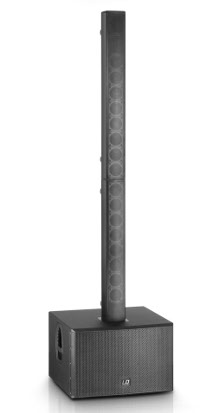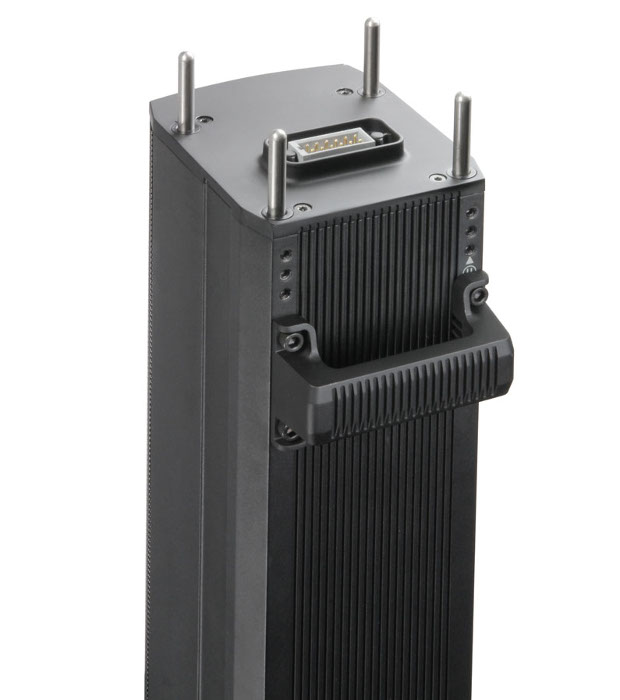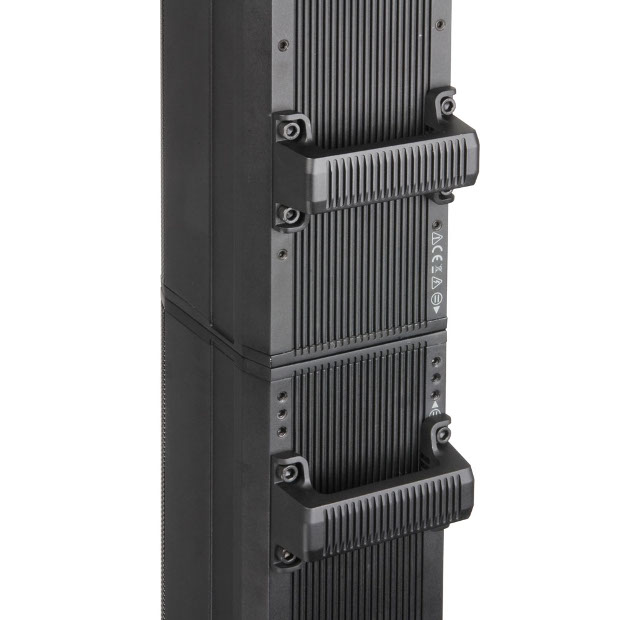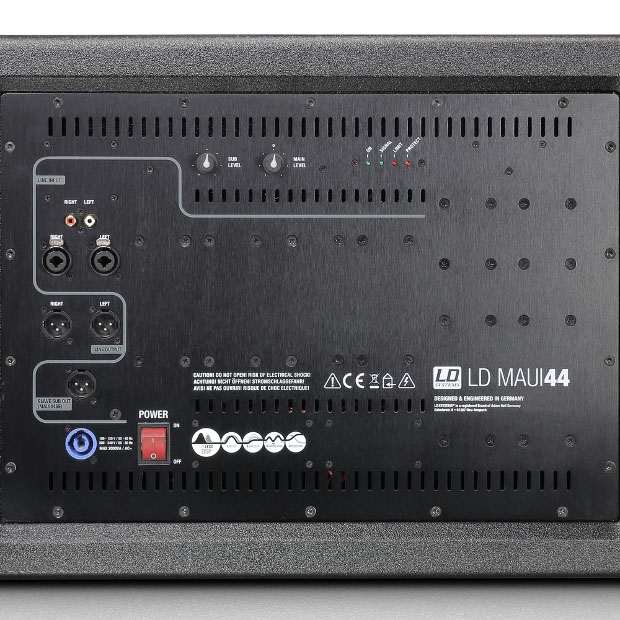LD Systems Maui 44 – line array and subwoofer – test report from tools4music
The initial hype surrounding compact column PAs is over but they still remain very much on trend. This is not only because they are easy to transport and set up, compact and visually discrete, but also because they offer impressive sound properties. LD Systems provides several line arrays in its MAUI series, including the 1,600-watt MAUI 44.

A male voice shouts up the stairwell – could someone come down please. Slightly irritated but curious, I head to the door and find a friendly courier standing by a full Euro-pallet of goods with a delivery note in his hand. It takes me a moment, I probably look surprised, but then I remember the LD Systems PA that’s meant to be delivered around now. And then I get on with the business of trying to wrestle the ‘booty’ into the (fortunately available) lift. It’s far from easy as the subwoofer alone weighs over 40 kg and the two column elements another 18 kg.
The MAUI 44 is the flagship of the series with 1,600 watts of system power (RMS) and a height of over 2.20 m when assembled. According to the manufacturer, this is a complete system, which is suitable for medium-sized venues with up to 300 people.
Subwoofer
The subwoofer module forms the heart of the system and is made from birch plywood (15 mm, bass reflex). The huge enclosure with a polyurethane finish offers enough space for not only two 12-inch neodymium subwoofers, but also as many as four DSP-supported class D amplifiers. On the back, there are two asymmetrical cinch inputs to enable the direct connection of equipment such as a CD player, smartphone, tablet or laptop for presentations.
Two symmetrical XLR/jack combi sockets furthermore receive the line level from a mixer or other stereo equipment. The actual output signal for the two column elements equipped with a total of 18 speakers is transmitted via the connector. This means that no additional cables are needed to use the system.
The left and right inputs are internally combined and then immediately passed to the tweeters and midrange speakers via the patch panel. The MAUI 44 additionally offers left and right line outputs if the incoming stereo signal should still be transmitted to other active speakers (monitors) or amplifiers, for example.
The slave sub-out also makes it possible to connect a subwoofer extension (MAUI 44 SE – additional cost point: about 1,000 euros) with a further 800 watts in order (DJs will be pleased to hear) to increase the bass performance. In addition to the main level control with carefully indexed positions, which can be used to control the PA’s performance, the output volume of the subwoofer can be almost infinitely adjusted on the system in line with personal preferences and the type of event.

You would perhaps go for a somewhat more powerful sub level for a party with a DJ but be rather more restrained when amplifying a string quartet. Non-slip rubber feet have been attached to not only the base but also the corners of the back panel. Why? For a very simple reason: as the subwoofer weighs around 40 kg, LD Systems offers a castor board (MAUI44 CB: 99 euros) to which the subwoofer can be attached with the rear panel facing downwards. The rubber feet and protruding enclosure frame protect potentiometers and sockets. Butterfly catches enable the sub to be securely attached to the castor board ready for transportation. A well-thought-out feature!
Columns
The MAUl 44 column system is designed as a mini line array and comprises two one-inch Celestion tweeters with ferrite magnets and a total of 16 independently developed neodymium tweeters/midrange speakers positioned one on top of the other. The speakers are distributed across two aluminium modules with handles on the back to enable the column elements to be easily assembled.

The bottom module has four steel pins on each end. These glide securely and with little force into the subwoofer at the one end and the top column module at the other. These push-in connections enable the three elements to be fastened together in an instant. The two tweeters are connected with a passive crossover switch and responsible for frequencies over 4,000 Hz. To also provide close-range sound, one of the two tweeters is tilted downwards at an angle of 7°.
The neodymium speakers are arranged in groups of four. The top quartet emits frequencies from 450 to 4,000 Hz, the next one down from 150 to 1,500 Hz, the third one down from 150 to 850 Hz and the bottom one from 150 to 650 Hz.
Compared to stereo arrangements, the central sound solution offers the advantage of standardised sound wave propagation from a single point in the room. This eliminates the problem of overlapping sound waves in the diffuse field and the higher noise level density that results from this. Furthermore, unlike conventional speaker systems, which emit a spherical wave, the line array emits a cylindrical wave, which offers several benefits: at twice the distance from the source, the intensity reduces by 3 dB, i.e. is still half the original intensity. With spherical waves emitters, the reduction is 6 dB.
Line arrays can therefore have a greater range than conventional speaker systems at the same volume. The controlled distribution properties (the angle of the MAUI is 120°) also keep the diffuse field small and enable a large number of listeners to enjoy the unadulterated pleasure of direct sound.
And anyone who has been dying to comment that a wide stereo panorama is important for a successful sound is falling into a common trap. The rule of thumb that states that all important information should be in the mid-range (monophonic) doesn’t only apply to ‘smaller PA systems’. Only effects such as the hall effect or delays are truly stereophonically emitted. Of course, you don’t have to follow this rule and, when skilfully used, sophisticated PA systems provide plenty of examples of there being other options too.

But stereophonic sound only works really well in a simple context if the speakers are no more than about four to five metres apart. Otherwise, the dreaded central hole occurs, destroying the meticulously arranged panorama.
Furthermore, the stereophonic listening experience is linked to a single sweet-spot in the middle of the speakers (stereo isosceles triangle). In other words: a few listeners can enjoy the stereophonic sound from a frontal PA system with an arranged panorama (guitar left, bass right, drums centre, keyboard semi-left) but most people have a sub-optimum experience.
With the MAUI 44 system, both situations are conceivable as this sound solution can be used as both a compact column system with one or two subwoofers or as a stereo PA by installing two columns and a subwoofer on the stage. However, this means having to buy two systems, with a cost point of around 4,000 euros.
LECC DSP
The MAUI 44’s DSP-supported amplifier should optimise the line array’s sound dispersion to achieve good sound field coverage and balanced sound dispersion. However, this means that incoming signals are initially transformed into a digital data flow of 24 bits at 48 kHz before undergoing the sophisticated processing and finally being re-subjected to a DIA conversion.
The benefits of precisely processing the live sound should be seen as more important than any potential sound losses as we are talking about stage sound and not the desired quality of a 96 bit/192 kHz recording session.
LD Systems refers to the digital sound processing as LECC-DSP (limiter, equaliser, compressor, crossover). The system has four separate multiband limiters (hi-mid, mid, low-mid and subwoofer). This should make it possible to intercept critical peaks in each of the frequency areas and avoid overloading/distortion so that the system can be used with a higher sound pressure. An additional protective feature switches the system off automatically in the case of an overload. Status LEDs on the back of the sub can be used to monitor the limiter and protection activity.
For the line array to work, the individual speakers must be optimally coordinated with one another. To enable this, LD Systems works with multiband EQs, which equalise and adjust the four frequency areas just like the limiter section.
An additional compressor specifically compresses the bass tones to achieve a more powerful sound. The intelligent bass-boost lowers as the volume increases so that the sound does not become too bass heavy at higher volumes. As the fourth member of the team, the digital crossover should optimise the amplitudes and run time to enable the most uniform possible sound wave propagation across the entire frequency area.
In practice
I have to admit that I was a little sceptical before entering a room with about 100 people. Without any reason to be, as it turned out. However, one thing you should be clear about is that the MAUI 44 may well be classed as a compact PA but it still weighs a tonne. Any solo artist or DJ who wants to travel around with the system should therefore think about who is going to help them assemble and disassemble it. If you are on your own and need to move the system over longer distances, I can recommend using the castor board to protect your back and transport the PA from A to B without too much hassle.

As an alternative, LD Systems also offers smaller PA siblings in the form of the MAUI 28 and the MAUI 11. Once on site, everything goes really quickly. The sub is positioned centrally to the audience about 50 cm away from the back wall, while the two column elements are unpacked and fastened together in just two minutes. All that is left is to connect the power and the PA system is ready. To mix the guitar signal and the two vocals, I used my Schertler ‘Unico’, which I position as a monitor facing the stage. I don’t mike up the Bechstein grand piano in the room but instead adjust the volume to the acoustic piano. I hadn’t expected things to be so simple, as the system is positioned behind the microphones. There should be plenty of power for this room (maximum 150 people) – and the MAUI 44 still has plenty in reserve in case the packed room needs a little more of a boost.
I adjust the sub during the soundchecks for the guitar and vocals and quickly find a setting that works well with the overall sound. The sound offers everything you could want but the audio material (vocals, guitar, grand piano) is also manageable. The bass is crisp; the phenomenon of washed-out mids seems unfamiliar to the MAUI 44.
I particularly like the fact that the PA isn’t dominating. This doesn’t mean that it’s too quiet but that it optimally carries the natural original sound experience. Supported by the Schertler Unico as a monitor, we find ourselves in a pleasant sound cloud, which optimally offers us what every musician wants on stage: a good, balanced and authentic sound.
This impression doesn’t change when I move in front of the PA either. As long as I remain in the ‘dispersion corridor’, I am optimally supplied with all information. The singer Ellen Schneider, who is now using the grand piano positioned to the side, also confirms this. Problematic? Definitely not, as the sound here is still carried extremely well and remains balanced.
We actually consider using a good-sounding, monophonic column system like the MAUI 44 as a PA system more often. In this context, the benefits impressed both the audience and the musicians.
Summary
As a 1,600-watt column PA, the MAUI 44 is not only easy to handle and quick to assemble but also offers the acoustic benefits of a line array and impresses with its, in the best sense of the word, unobtrusive manner in terms of both sound and appearance. In terms of natural playback, I’d say that the sound has everything you could want. Any small ensembles, duos, singer/songwriters or DJs who still use conventional PA solutions could certainly regard this as a new option for breaking from their routine. It could be worthwhile.
Statement from: Benjamin Lampert, R&D Manager at Adam Hall:
“We at Adam Hall are delighted with the positive response to our MAUI 44 and are proud that all the energy and hard work that we put into developing the system is now paying off. Based on the experiences that both we and users have had with the successful MAUI 28 and MAUI 11 models, during the development stage we were able to focus on fulfilling the new requirements to be met by the largest model in the series.
This resulted in a system that delivers the best performance yet in the series, while still being easy to use, looking elegant and being easy to transport. This makes the MAUI 44 a real all-rounder and a system that always looks great, whether as a stage PA, DJ system or public address system at a gala event. To meet the requirements of this broad range of uses, which means offering the most homogeneous possible close and long range dispersion, it was necessary to custom-make the system components.
This includes, for example, the specially developed 3.5-inch chassis and the tweeter wave guide, which essentially comes from our VA4 line array. It is now only natural that digital technologies, DSPs, efficient neodymium speaker components, switching power supplies and class D amplifiers have found their way into the products. But to get a performance like that of the MAUI 44 from the components available, requires very special expertise.
Thanks to intensive research, our engineers have achieved excellent results, in particular with regard to the programming of our LECC DSPs. They have found an optimum balance between maximum sound pressure and the functional reliability of the components, which is a challenge in itself with the fully convection-cooled system without fans. The aspects of a ‘homogeneous sound’ and ‘maximum possible dynamics’ also had to be considered when finding the balance.
The impressive sound result was only made possible by extremely delicately aligned multiband limiters, which also differentiate the MAUI 44 from other DSP-supported systems on the market. Our development department continues to work on interesting new products, so you can look forward to seeing what else 2015 will bring.”
Facts
Manufacturer: LD Systems
Model: MAUI 44
Analogue inputs: Une input L and R (XLR/jack combo socket, symmetrical); line input L and R (Cinch, asymmetrical)
Analogue outputs: line out L and R (XLR, symmetrical); column satellite directly connected using connector
Controls: 1 x volume control (system volume); 1 x sub-level (subwoofer adjustment)
Total specified output power: 1,600 (RMS)
Amplifier: class D
SPL maximal: 121 dB (continuous)
Frequency response: 40 Hz to 20 kHz
Dispersion angle: 120 degrees
Height: 222.3 cm
Weight: 58.4 kg
Special features: LECC DSP (limiter, equaliser, compressor, crossover), steel pin connection of the individual elements, passive cooling, protect switch, status LEDs
Subwoofer
Specified output power: 800 watts (RMS)
Type: band pass
Neodymium subwoofer: 2 x 12 inches
Material: 15 mm plywood
Finish: polyurethane
Dimensions: 620 x 412 x 615 cm
Weight 40.8 kg
Mid/hi system
Specified output power: 4 x 200 watt (RMS)
Chassis: tweeter 1 with wave guide (4 – 20 kHz), tweeter 2 with wave guide and 7° angle (4 – 20 kHz), 4 x top mids/treble (450 Hz – 4 kHz), 4 x mids (150 – 1,500 Hz), 4 x mids (150 – 850 Hz), 4 x lower mids (150 – 600 Hz)
Mid-range speaker: 16 x 3.5 inches (neodymium)
Mid-range speaker: 16 x 3.5 inches (neodymium)
Tweeter: 2 x 1 inch (ferrite Celestion)
Type: closed
Material: aluminium
Finish: powder-coated
Dimensions (top column): 120 x 973 x 144 cm
Weight 10.2 kg
Dimensions (bottom column): 120 x 838 x 144 cm
Weight: 7.4 kg
Pros
+ 1,600 watt system power (RMS)
+ balanced and natural sound
+ DSP-optimised (LECC: limiter, EQ, compressor, crossover)
+ can be expanded to include additional subwoofer
+ no connection cable thanks to push-together column elements
+ subtle visual appearance
+ protect switch provides overload protection
+ robust workmanship and sophisticated transport system (castor board attachment)
+ high-precision adjustable bass (sub level) with intelligent compressor
+ separate outputs for the connection of other (active) monitors
+ also universally suitable for presentations or events thanks to the amplification of acoustic instruments and vocals
+ four multiband limiters enable a higher overall sound pressure
Cons
– Weight
_____________________________
Source: tools4music magazine, April/May 2015, Germany: http://www.tools4music.de/ Author: Michael Nötges
Further information about the MAUI 44 can be found at:
http://www.ld-systems.com/en/series/maui-series/maui-44-column-pa-system-active/
Leave a Comment
You must be logged in to post a comment.












